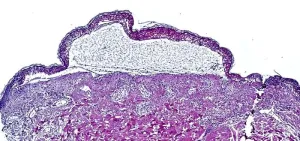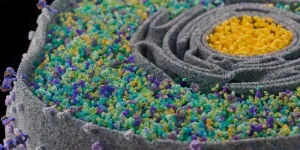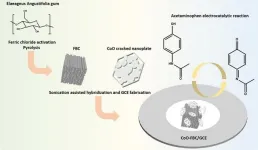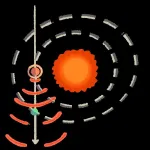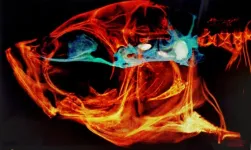(Press-News.org) The researchers used spatial proteomics to analyze skin samples from patients with toxic epidermal necrolysis. This cutting-edge approach, known as Deep Visual Proteomics, merges powerful microscopy with AI-driven analysis, laser-guided microdissection and ultimately ultra-high sensitivity mass spectrometry. They zoomed in on individual cells and studied them like never before, creating a map of the thousands of proteins driving this deadly reaction.
Thierry Nordmann, first author, clinician-scientist at the Max Planck Institute of Biochemistry and senior dermatologist at the Ludwig Maximilians Universität München explains: “By applying spatial proteomics to archived patient samples suffering from toxic epidermal necrolysis, we were able to precisely isolate and analyze individual cell types and understand what is actually occurring in the skin of these patients. We identified a striking hyperactivation of the inflammatory JAK/STAT pathway, revealing an opportunity to intervene in this deadly condition with JAK inhibitors, a class of drugs already used to treat other inflammatory conditions, such as atopic dermatitis or rheumatoid arthritis."
Toxic epidermal necrolysis is a rare but extremely severe adverse reaction to common medications, such as allopurinol (which is used to treat gout) or certain antibiotics. It causes widespread blistering and detachment of the skin. With a mortality rate of up to 30 percent, it rapidly transforms from a seemingly harmless rash into a life-threatening condition. Until now, no effective therapy existed, with treatment primarily limited to supportive care.
The team validated their findings across a variety of preclinical studies, including in vitro models and two distinct mouse models. The results were consistent and overwhelmingly positive: JAK inhibitors show real potential in treating this devastating condition. These discoveries were further strengthened by a global collaboration across six countries, demonstrating the power of partnership in solving urgent medical challenges.
A new therapy for patients?
In partnership with clinical teams led by Chao Ji at the First Affiliated Hospital of Fujian medical University in China, they administered JAK inhibitors to patients suffering from toxic epidermal necrolysis. Remarkably, all seven patients experienced rapid improvement and full recovery upon treatment.
Lars French, co-corresponding author and Chair of Dermatology at LMU Munich, says: "The new evidence that inhibition of the JAK/STAT pathway has potential to reduce the high mortality of this severe adverse cutaneous drug reaction paves the way for clinical trials aimed at regulatory approval of JAK inhibitors to solve one of the most serious unmet needs in medicine."
While larger clinical trials are needed to confirm the efficacy and safety of JAK inhibitors in toxic epidermal necrolysis, this study provides hope for patients facing this devastating condition. It also opens up new opportunities for drug repurposing and development. The Max Planck Society has filed patent applications together with the Ludwig Maximilian University for the use of JAK inhibitors in treating toxic epidermal necrolysis and related conditions, creating potential for further development.
"Our findings not only open new avenues for treating this reaction, but also highlight the potential of spatial proteomics in driving medical breakthroughs," says Matthias Mann. "To our knowledge, this is the first time a spatial omics technology has made an immediate and tangible impact in the clinic, by identifying a treatment that has already changed people's lives for the good. This approach could be applied to a wide range of diseases, potentially accelerating drug discovery across multiple fields of medicine."
END
Breakthrough technology leads to life-saving treatment for deadly skin reaction
Spatial proteomics provides therapeutic approach for patients with toxic epidermal necrolysis – off-label use of JAK inhibitors in first patients worldwide leads to complete recovery
2024-10-16
ELSE PRESS RELEASES FROM THIS DATE:
One in three plants call islands home
2024-10-16
A new study has revealed that islands are home to around one in three of the world’s plant species, despite covering just over five per cent of the Earth’s land surface.
Dr Julian Schrader, from Macquarie University’s School of Natural Sciences, led a team of a dozen researchers from Australia, Germany, Spain, USA, Greece and Japan in analysing data on more than 304,103 plants – essentially all species known to science worldwide – uncovering a treasure trove of island biodiversity.
The team found 94,052 species are native to islands. Of these, 63,280 are endemic –found nowhere else in the world – representing 21 per cent of global plant diversity.
The ...
Challenging current understanding, study reveals rapid release of dopamine not needed for initiating movement
2024-10-16
The chemical messenger dopamine is an essential catalyst that fuels activities and behaviors ranging from movement to cognition and learning. However, neuroscientists have long debated whether these functions rely on rapid bursts of dopamine or on the neurochemical’s slower action.
A new study led by researchers at Harvard Medical School provides an answer.
The work, conducted in mice and published Oct. 16 in Nature, shows that initiating movement doesn’t require a rapid burst of dopamine but instead relies on slow activity of the chemical over time. By contrast, reward-oriented behaviors, related to ...
CSIRO research reveals marine heatwaves are underreported in the deep ocean
2024-10-16
While marine heatwaves (MHWs) have been studied at the sea surface for more than a decade, new research published today in Nature has found 80 per cent of MHWs below 100 metres are independent of surface events, highlighting a previously overlooked aspect of ocean warming.
The study was conducted by Australia’s national science agency CSIRO and the Chinese Academy of Sciences.
MHWs are prolonged temperature events that can cause severe damage to marine habitats, such as impacts to coral reefs and species displacement. These events are becoming more frequent due to global warming, with notable occurrences off Australia’s East ...
Meat without vegetables: How bacteria in our stomachs today can tell us what was on the menu for the first humans
2024-10-16
In a study published in Nature, Prof. Daniel Falush of the Shanghai Institute of Immunity and Infection (SIII) of the Chinese Academy of Sciences, Prof. Yoshio Yamaoka of Oita University, Japan, and Prof. Kaisa Thorell of Gothenberg University, Sweden uncovered fascinating new details about the long association of humans and our stomach bacteria.
Since its discovery in 1983, Helicobacter pylori has become notorious as the cause of around a million cases of stomach cancer a year as well as other life-threatening gastric diseases. The bacterium is ...
Protein interactions: Who is partying with whom and who is ruining the party?
2024-10-16
Inside cells, it's like in a packed dance club: hundreds are partying. Some keep to themselves, others make their way through the crowd, chatting to everyone they meet. Some just say a quick hello, others stay with their best friends. In this club, there are all kinds of different interactions between party-goers. The same is the case in cells with proteins.
Cells are filled with many different types of proteins that interact with each other and often work together in groups. These groups are called complexes ...
New biochar nanocomposite enhances detection of acetaminophen and uric acid in urine
2024-10-16
In recent years, the excessive use of acetaminophen (APAP) has become a significant human hazard and social burden. Rapid and automated electrochemical detection has emerged as a crucial method for measuring APAP concentration in human urine. This study explores a novel porous cobalt-derived biomass electrocatalyst material prepared from Elaeagnus angustifolia gum and investigates its electrochemical properties as well as its specific detection capability for APAP. Their work is published in the journal Industrial Chemistry & Materials on 18 July 2024.
Acetaminophen (APAP) is a commonly used analgesic and antipyretic ...
F. William Studier receives the 2024 Merkin Prize in ceremony at the Broad Institute for developing technology used to produce millions of doses of COVID-19 vaccines
2024-10-16
The 2024 Richard N. Merkin Prize in Biomedical Technology was awarded to F. William Studier of Brookhaven National Laboratory in a ceremony and symposium at the Broad Institute on September 17, 2024. The prize, created by the Merkin Family Foundation and administered by the Broad, recognizes novel technologies that have significantly improved human health and carries a $400,000 award. [Event Video]
Studier was announced as the winner in May for his development, in 1986, of an efficient, scalable method of producing ...
Applications open for School of Advanced Science on Structural Safety
2024-10-16
The “São Paulo School of Advanced Science on Structural Safety and its role in reducing greenhouse gas emissions by the built environment” will be held May 3-16, 2025, in Brazil, at the São Carlos School of Engineering of the University of São Paulo in its São Carlos campus.
Reporters are invited to register for the scientific sessions and short courses, which will present state-of-art science and results of new research.
This advanced science school will address the main challenges related to Structural Safety ...
Scientists use Allen Telescope Array to search for radio signals in the TRAPPIST-1 star system
2024-10-16
October 16, 2024, Mountain View, CA - Scientists at the SETI Institute and partners from Penn State University used the Allen Telescope Array (ATA) to search for signs of alien technology in the TRAPPIST-1 star system. The team spent 28 hours scanning the system, looking for radio signals that could indicate extraterrestrial technology. This project marks the longest single-target search for radio signals from TRAPPIST-1. Although they didn’t find any evidence of extraterrestrial technology, their work provided valuable data ...
Zebrafish as a model for studying rare genetic disease
2024-10-16
Fukuoka, Japan—Nager syndrome, or NS, is a rare genetic disease that affects the development of the face and limbs, usually causing anomalies in the bone structures of the jaws, cheeks, and hands. With a prevalence of less than 100 cases ever reported, not much is known about the disease except the fact that mutations in the SF3B4 gene are its primary cause. Now, in a recent study made available online on September 15, 2024 and upcoming in the November issue of International Journal of Biological Macromolecules, researchers from Kyushu University have developed a convenient approach to explore the underlying mechanisms ...
LAST 30 PRESS RELEASES:
This self-powered eye tracker harnesses energy from blinking and is as comfortable as everyday glasses
Adverse prenatal exposures linked to higher rates of mental health issues, brain changes in adolescents
Restoring mitochondria shows promise for treating chronic nerve pain
Nature study identifies a molecular switch that controls transitions between single-celled and multicellular forms
USU chemists' CRISPR discovery could lead to single diagnostic test for COVID, flu, RSV
Early hominins from Morocco reveal an African lineage near the root of Homo sapiens
Small chimps, big risks: What chimps show us about our own behavior
We finally know how the most common types of planets are created
Thirty-year risk of cardiovascular disease among healthy women according to clinical thresholds of lipoprotein(a)
Yoga for opioid withdrawal and autonomic regulation
Gene therapy ‘switch’ may offer non-addictive pain relief
Study shows your genes determine how fast your DNA mutates with age
Common brain parasite can infect your immune cells. Here's why that's probably OK
International experts connect infections and aging through cellular senescence
An AI–DFT integrated framework accelerates materials discovery and design
Twist to reshape, shift to transform: Bilayer structure enables multifunctional imaging
CUNY Graduate Center and its academic partners awarded more than $1M by Google.org to advance statewide AI education through the Empire AI consortium
Mount Sinai Health system receives $8.5 million NIH grant renewal to advance research on long-term outcomes in children with congenital heart disease
Researchers develop treatment for advanced prostate cancer that could eliminate severe side effects
Keck Medicine of USC names Christian Pass chief financial officer
Inflatable fabric robotic arm picks apples
MD Anderson and SOPHiA GENETICS announce strategic collaboration to accelerate AI-driven precision oncology
Oil residues can travel over 5,000 miles on ocean debris, study finds
Korea University researchers discover that cholesterol-lowering drug can overcome chemotherapy resistance in triple-negative breast cancer
Ushikuvirus: A newly discovered giant virus may offer clues to the origin of life
Boosting the cell’s own cleanup
Movement matters: Light activity led to better survival in diabetes, heart, kidney disease
Method developed to identify best treatment combinations for glioblastoma based on unique cellular targets
Self-guided behavioral app helps children with epilepsy sleep earlier
Higher consumption of food preservatives is associated with an increased risk of type 2 diabetes
[Press-News.org] Breakthrough technology leads to life-saving treatment for deadly skin reactionSpatial proteomics provides therapeutic approach for patients with toxic epidermal necrolysis – off-label use of JAK inhibitors in first patients worldwide leads to complete recovery
